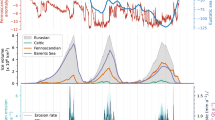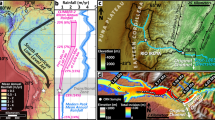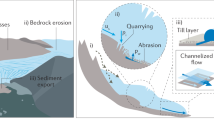Abstract
Since the late nineteenth century, it has been debated whether rivers or glaciers are more effective agents of erosion1. The dramatic landscapes associated with glaciated terrain have often led to the argument that glaciers are more erosive than rivers, and recent studies have documented the topographic signature of an ice-controlled limit of mountain height known as the ‘glacial buzz-saw’2,3. Here we present a new global compilation of erosion rates, which questions the conventional view of glaciers and erosion. In regions of rapid tectonic uplift, erosion rates from rivers and glaciers both range from 1 to over 10 mm yr−1, indicating that both are capable of generating erosion rates matching or exceeding the highest rates of rock uplift. Moreover, a comparison of erosion rates over timescales ranging from 101 to 107 years indicates that glacial erosion tends to decrease by one to two orders of magnitude over glacial cycles, whereas fluvial erosion rates show no apparent dependence on time. We conclude that tectonics controls rates of both fluvial and glacial erosion over millennial and longer timescales and that the highest rates of erosion (>10 mm yr−1) generally result from a transient response to disturbance by volcanic eruptions, climate change and modern agriculture.
This is a preview of subscription content, access via your institution
Access options
Subscribe to this journal
Receive 12 print issues and online access
$259.00 per year
only $21.58 per issue
Buy this article
- Purchase on Springer Link
- Instant access to full article PDF
Prices may be subject to local taxes which are calculated during checkout



Similar content being viewed by others
References
Tyndall, J. On the conformation of the Alps. Phil. Mag. 24, 169–173 (1862).
Brozovic, N., Burbank, D. W. & Meigs, A. J. Climatic limits on landscape development in the Northwestern Himalaya. Science 276, 571–574 (1997).
Mitchell, S. G. & Montgomery, D. R. Influence of a glacial buzzsaw on the height and morphology of the Cascade Range in central Washington State, USA. Quat. Res. 65, 96–107 (2006).
Hallet, B., Hunter, L. & Bogen, J. Rates of erosion and sediment evacuation by glaciers: A review of field data and their implications. Glob. Planet. Change 12, 213–235 (1996).
Gurnell, A. M., Hannah, D. & Lawler, D. Erosion and Sediment Yield: Global and Regional Perspectives 97–104 (Intl Assoc. Hydro. Sci. Pub. 236, 1996).
Koppes, M. & Hallet, B. Erosion rates during rapid deglaciation in Icy Bay, Alaska. J. Geophys. Res. 111, F02023 (2006).
Berger, A. L. & Spotila, J. A. Denudation and deformation in a glaciated orogenic wedge: The St. Elias orogen, Alaska. Geology 36, 523–526 (2008).
Burbank, D. W. et al. Bedrock incision, rock uplift and threshold hillslopes in the northwestern Himalaya. Nature 379, 505–510 (1996).
Pratt-Situala, B., Burbank, D., Heimsath, A. & Ohja, T. Landscape disequilibrium in 1,000–10,000 yr scales Marysandi River, Nepal, central Himalaya. Geomorphology 58, 223–241 (2004).
Dadson, S. J. et al. Links between erosion, runoff variability and seismicity in the Taiwan orogen. Nature 426, 448–451 (2003).
Heimsath, A. M., Chappell, J., Dietrich, W. E., Nishiizumi, K. & Finkel, R. C. Soil production on a retreating escarpment in southeastern Australia. Geology 28, 787–790 (2000).
Bierman, P. & Caffee, M. Cosmogenic exposure and erosion history for Australian bedrock landforms. Geol. Soc. Am. Bull. 114, 787–803 (2002).
Reneau, S. L. & Dietrich, W. E. Erosion rates in the southern Oregon Coast Range: Evidence for an equilibrium between hillslope erosion and sediment yield. Earth Surf. Proc. Land. 16, 307–322 (1991).
Gendaszek, A. S., Stone, J. & Balco, G. Spatial models of erosion in mountain catchments constrained by cosmogenic 10-Be. Eos 87, Fall Meet. Suppl., Abstr. H13E-1443 (2006).
Syvitski, J. P. M. & Milliman, J. D. Geology, geography, and humans battle for dominance over the delivery of fluvial sediment to the coastal ocean. J. Geol. 115, 1–19 (2007).
Lavé, J. & Avouac, J. P. Fluvial incision and tectonic uplift across the Himalayas of central Nepal. J. Geophys. Res. 106, 26561–26591 (2001).
Gran, K. B. & Montgomery, D. R. Spatial and temporal patterns in fluvial recovery following volcanic eruptions: Channel response to basin-wide sediment loading at Mount Pinatubo, Philippines. Geol. Soc. Am. Bull. 117, 195–211 (2005).
Koppes, M. N., Hallet, B. & Anderson, J. A. Synchronous acceleration of ice loss and glacial erosion, Glaciar Marinelli, Chilean Tierra del Fuego. J. Glaciol. 55, 207–220 (2009).
Gardner, T. W., Jorgensen, D. W., Shuman, C. & Lemieux, C. R. Geomorphic and tectonic process rates: Effects of measured time interval. Geology 15, 259–261 (1987).
Sheaf, M. A., Serpa, L. & Pavlis, T. L. Exhumation rates in the St. Elias mountains, Alaska. Tectonophysics 367, 1–11 (2003).
Ehlers, T., Farley, K. A., Rusmore, M. E. & Woodsworth, G. J. Apatite(U–Th)/He signal of large-magnitude accelerated glacial erosion, southwest British Columbia. Geology 34, 765–768 (2006).
Koppes, M., Hallet, B. & Stewart, R. Glacial erosion rates and climate influences in Chilean Patagonia. Eos 87, Fall Meet. Suppl., Abstr. C14A-07 (2006).
Vance, D., Bickle, M., Ivy-Ochs, S. & Kubik, P. W. Erosion and exhumation in the Himalaya from cosmogenic isotope inventories of river sediments. Earth Planet. Sci. Lett. 206, 273–288 (2003).
Cyr, A. & Granger, D. Dynamic equilibrium among erosion, river incision, and coastal uplift in the northern and central Apennines, Italy. Geology 36, 103–106 (2008).
Bishop, P. SE Australian late Mesozoic and Cenozoic denudation rates: A test for late Tertiary increases in continental denudation. Geology 13, 479–482 (1985).
Howat, I. M., Joughin, I., Tulaczyk, S. & Gogineni, S. Rapid retreat and acceleration of Helhiem Glacier, east Greenland. Geophys. Res. Lett. 32, L22502 (2005).
Rignot, E., Rivera, A. & Casassa, G. Contribution of the Patagonia Icefields of South America to sea level rise. Science 302, 434–437 (2003).
Montgomery, D. R. Soil erosion and agricultural sustainability. Proc. Natl Acad. Sci. USA 104, 13268–13272 (2007).
Brandon, M. T., Roden-Tice, M. K. & Garver, J. I. Late Cenozoic exhumation of the Cascadia accretionary wedge in the Olympic Mountains, northwest Washington State. Geol. Soc. Am. Bull. 110, 985–1009 (1998).
Reiners, P. W., Ehlers, T. A., Mitchell, S. G. & Montgomery, D. R. Coupled spatial variations in precipitation and long-term erosion rates across the Washington Cascades. Nature 426, 645–647 (2003).
Acknowledgements
The authors wish to thank B. Hallet for the many discussions related to the development of this work.
Author information
Authors and Affiliations
Contributions
Both authors contributed to the analysis and preparation of the manuscript. M.N.K. led the collection and review of the relevant literature and analysis of the datasets.
Corresponding author
Rights and permissions
About this article
Cite this article
Koppes, M., Montgomery, D. The relative efficacy of fluvial and glacial erosion over modern to orogenic timescales. Nature Geosci 2, 644–647 (2009). https://doi.org/10.1038/ngeo616
Received:
Accepted:
Published:
Issue Date:
DOI: https://doi.org/10.1038/ngeo616
This article is cited by
-
Sediment discharge from Greenland’s marine-terminating glaciers is linked with surface melt
Nature Communications (2024)
-
Ice flux of alpine glaciers controls erosion and landscape in the Nianbaoyeze Shan, northeastern Tibetan Plateau
Journal of Mountain Science (2023)
-
Warming-driven erosion and sediment transport in cold regions
Nature Reviews Earth & Environment (2022)
-
The extreme yet transient nature of glacial erosion
Nature Communications (2022)
-
A paleo-perspective on West Antarctic Ice Sheet retreat
Scientific Reports (2022)



